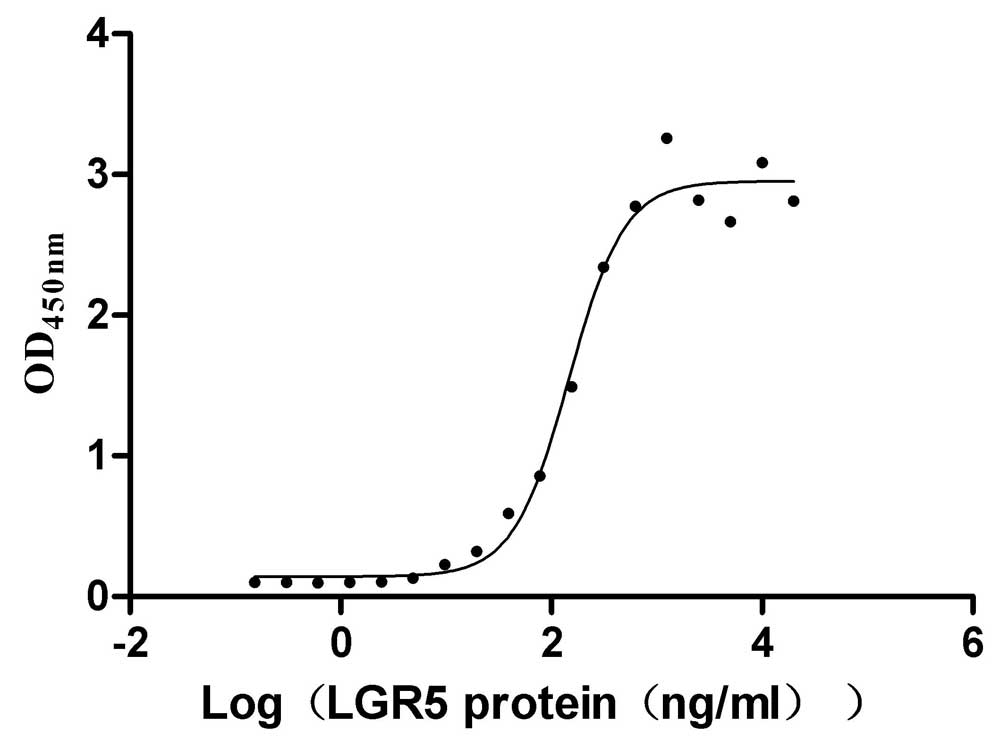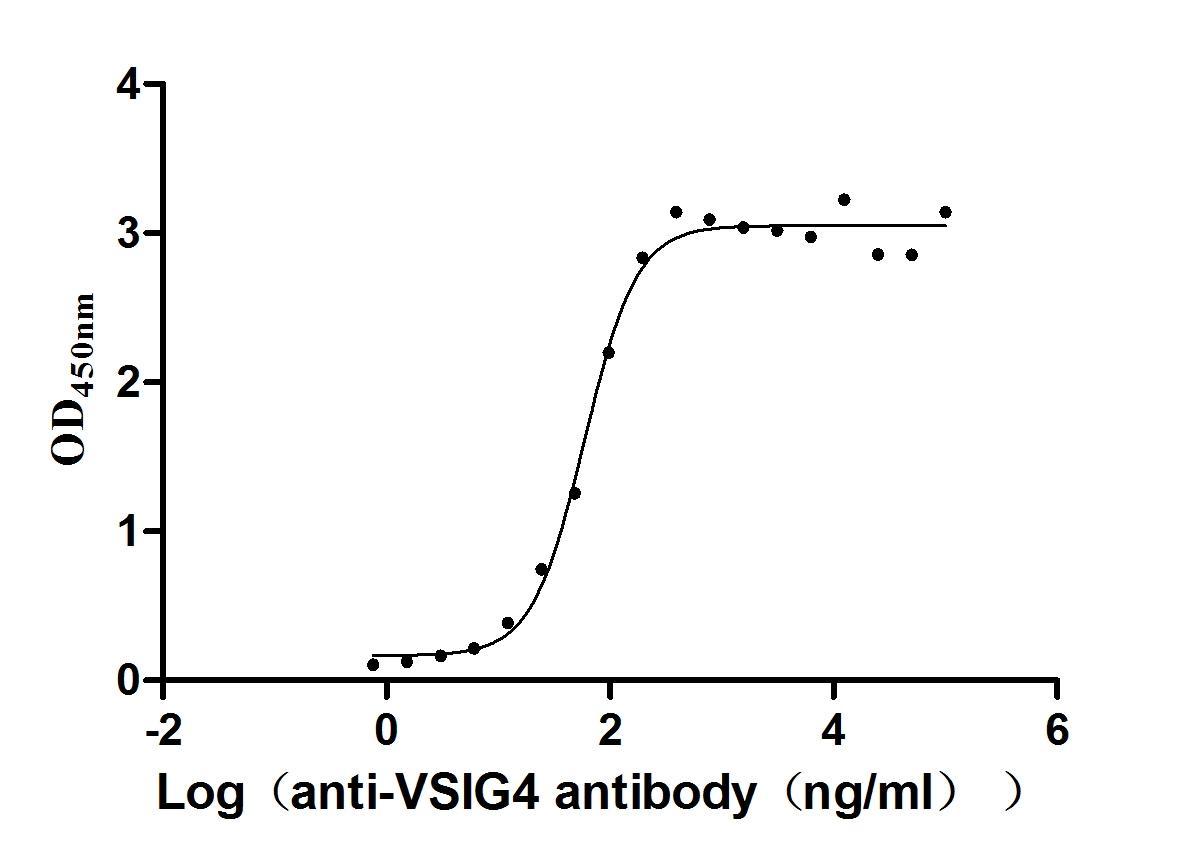Recombinant Mouse Interferon-induced transmembrane protein 3 (Ifitm3)
-
中文名稱:Recombinant Mouse Interferon-induced transmembrane protein 3 (Ifitm3)
-
貨號(hào):CSB-CF875121MO(A4)
-
規(guī)格:¥9720
-
圖片:
-
其他:
產(chǎn)品詳情
-
純度:Greater than 85% as determined by SDS-PAGE.
-
生物活性:Not Test
-
基因名:Ifitm3
-
Uniprot No.:
-
別名:Dispanin subfamily A member 2b;DSPA2b;Fragilis protein;Interferon-inducible protein 15;Mouse ifitm-like protein 1;Mil-1
-
種屬:Mus musculus (Mouse)
-
蛋白長度:Full Length
-
來源:in vitro E.coli expression system
-
分子量:16.5 kDa
-
表達(dá)區(qū)域:1-137aa
-
氨基酸序列MNHTSQAFITAASGGQPPNYERIKEEYEVAEMGAPHGSASVRTTVINMPREVSVPDHVVWSLFNTLFMNFCCLGFIAYAYSVKSRDRKMVGDVTGAQAYASTAKCLNISTLVLSILMVVITIVSVIIIVLNAQNLHT
Note: The complete sequence including tag sequence, target protein sequence and linker sequence could be provided upon request. -
蛋白標(biāo)簽:N-terminal 10xHis-tagged
-
產(chǎn)品提供形式:Liquid or Lyophilized powder
Note: We will preferentially ship the format that we have in stock, however, if you have any special requirement for the format, please remark your requirement when placing the order, we will prepare according to your demand. -
緩沖液:If the delivery form is liquid, the default storage buffer is Tris/PBS-based buffer, 5%-50% glycerol. If the delivery form is lyophilized powder, the buffer before lyophilization is Tris/PBS-based buffer, 6% Trehalose, pH 8.0.
-
復(fù)溶:We recommend that this vial be briefly centrifuged prior to opening to bring the contents to the bottom. Please reconstitute protein in deionized sterile water to a concentration of 0.1-1.0 mg/mL.We recommend to add 5-50% of glycerol (final concentration) and aliquot for long-term storage at -20℃/-80℃. Our default final concentration of glycerol is 50%. Customers could use it as reference.
-
儲(chǔ)存條件:Store at -20°C/-80°C upon receipt, aliquoting is necessary for mutiple use. Avoid repeated freeze-thaw cycles.
-
保質(zhì)期:The shelf life is related to many factors, storage state, buffer ingredients, storage temperature and the stability of the protein itself.
Generally, the shelf life of liquid form is 6 months at -20°C/-80°C. The shelf life of lyophilized form is 12 months at -20°C/-80°C. -
貨期:Delivery time may differ from different purchasing way or location, please kindly consult your local distributors for specific delivery time.
-
注意事項(xiàng):Repeated freezing and thawing is not recommended. Store working aliquots at 4℃ for up to one week.
-
Datasheet & COA:Please contact us to get it.
相關(guān)產(chǎn)品
靶點(diǎn)詳情
-
功能:IFN-induced antiviral protein which disrupts intracellular cholesterol homeostasis. Inhibits the entry of viruses to the host cell cytoplasm by preventing viral fusion with cholesterol depleted endosomes. May inactivate new enveloped viruses which buds out of the infected cell, by letting them go out with a cholesterol depleted membrane. Active against multiple viruses, including influenza A virus, SARS coronaviruses (SARS-CoV and SARS-CoV-2), Marburg virus (MARV), Ebola virus (EBOV), Dengue virus (DNV), West Nile virus (WNV), human immunodeficiency virus type 1 (HIV-1), hepatitis C virus (HCV) and vesicular stomatitis virus (VSV). Can inhibit: influenza virus hemagglutinin protein-mediated viral entry, MARV and EBOV GP1,2-mediated viral entry, SARS-CoV and SARS-CoV-2 S protein-mediated viral entry and VSV G protein-mediated viral entry. Plays a critical role in the structural stability and function of vacuolar ATPase (v-ATPase). Establishes physical contact with the v-ATPase of endosomes which is critical for proper clathrin localization and is also required for the function of the v-ATPase to lower the pH in phagocytic endosomes thus establishing an antiviral state. In hepatocytes, IFITM proteins act in a coordinated manner to restrict HCV infection by targeting the endocytosed HCV virion for lysosomal degradation. IFITM2 and IFITM3 display anti-HCV activity that may complement the anti-HCV activity of IFITM1 by inhibiting the late stages of HCV entry, possibly in a coordinated manner by trapping the virion in the endosomal pathway and targeting it for degradation at the lysosome. Exerts opposing activities on SARS-CoV-2, including amphipathicity-dependent restriction of virus at endosomes and amphipathicity-independent enhancement of infection at the plasma membrane.
-
基因功能參考文獻(xiàn):
- The extracellular level of Fstl1 is regulated by Ifitm3 in astrocytes, which could be involved in polyI:C-induced neurodevelopmental impairment. PMID: 30348171
- contrary to its role in enhancing DNA virus replication, LSD1 limits RNA virus replication by demethylating and activating IFITM3 which is a host restriction factor for many RNA viruses PMID: 29281729
- IFITM1 and IFITM3 inhibit Zika virus infection early in the viral life cycle. PMID: 27268505
- ZMPSTE24 is a downstream effector of IFITM3 and is important for interferon-induced transmembrane antiviral activity. PMID: 28594571
- IFITM3 represents a checkpoint regulator of antiviral immunity that controls cytokine production to restrict viral pathogenesis. PMID: 28240600
- Collectively, the data define an antiviral role for Ifitm3 in restricting infection of multiple alphaviruses. PMID: 27440901
- Ifitm3 plays a role in mouse primordial germ cell homing and repulsion by enhancing the regionalization of PGCs. PMID: 16326387
- Ifitm3 does not impact on the restriction or pathogenesis of bacterial (Salmonella typhimurium, Citrobacter rodentium, Mycobacterium tuberculosis) or protozoan (Plasmodium berghei) pathogens, despite in vitro evidence. PMID: 24278312
- results suggest that modification of Tyr(20) may serve in a cellular checkpoint controlling IFITM3 trafficking and degradation and demonstrate the complexity of posttranslational regulation of IFITM3 PMID: 24627473
- It acts as a defence factor for virus infection, though, it also suppress endocytosis of astroglia, which results in neurodevelopmental impairment.(review) PMID: 24212590
- Interferon-induced transmembrane protein 3 is a type II transmembrane protein. PMID: 24067232
- results revealed diverse, yet consistent, profiles of IFITM3 localization throughout the gastrula PMID: 23639725
- Induction of IFITM3 expression in astrocytes leads to brain dysfunction by impairing neurite development and other non-cell autonomous effects such as increasing mRNA levels of inflammatory cytokines. PMID: 23382131
- Jin Chai antiviral capsule exerts antiviral effects against influenza virus by raised expression of IFITM3. PMID: 22993855
- lung TRM cells were programmed to retain IFITM3 expression, which facilitated their survival and protection from viral infection during subsequent exposures PMID: 23354485
- A central role for Ifitm3 in limiting acute influenza in vivo. PMID: 22969429
- IFITM3 is essential for defending the host against influenza A virus in vivo; mice lacking Ifitm3 display fulminant viral pneumonia when challenged with a normally low-pathogenicity influenza virus, mirroring the destruction inflicted by the highly pathogenic 1918 'Spanish' influenza PMID: 22446628
- S-palmitoylation and ubiquitination differentially regulate interferon-induced transmembrane protein 3 (IFITM3)-mediated resistance to influenza virus. PMID: 22511783
- Specific deletion of KLF4 led to IFITM3 overexpression in colon mucosa in Villin-Cre+ ;Klf4 fl/fl mice. PMID: 21531817
- cloning and expression of the mouse gene interferon-inducible-protein 15 (IP15), whose activation is related to the acute phase of experimental pancreatitis [IP15] PMID: 15184081
- analysis of regulation of Ifitm3 in mouse germ cells PMID: 15254899
- Act1 adaptor protein is an immediate and essential signaling component of interleukin-17 receptor PMID: 17035243
- Targeted chromosome engineering was used to generate mutants which either lack the entire Ifitm locus or carry a disrupted Ifitm3 gene only. PMID: 18505827
顯示更多
收起更多
-
亞細(xì)胞定位:Cell membrane; Single-pass type II membrane protein. Late endosome membrane; Single-pass type II membrane protein. Early endosome membrane; Single-pass type II membrane protein. Lysosome membrane; Single-pass type II membrane protein. Cytoplasm, perinuclear region.
-
蛋白家族:CD225/Dispanin family
-
組織特異性:Expressed in acinar cell. Predominantly expressed in nascent primordial germ cells, as well as in gonadal germ cells.
-
數(shù)據(jù)庫鏈接:
Most popular with customers
-
Recombinant Human Heat-stable enterotoxin receptor (GUCY2C), partial (Active)
Express system: Mammalian cell
Species: Homo sapiens (Human)
-
Recombinant Human IGF-like family receptor 1 (IGFLR1), partial (Active)
Express system: Mammalian cell
Species: Homo sapiens (Human)
-
Recombinant Human R-spondin-1 (RSPO1), partial (Active)
Express system: Mammalian cell
Species: Homo sapiens (Human)
-
Recombinant Human Somatostatin receptor type 2 (SSTR2)-VLPs (Active)
Express system: Mammalian cell
Species: Homo sapiens (Human)
-
Recombinant Human V-set and immunoglobulin domain-containing protein 4 (VSIG4), partial (Active)
Express system: Mammalian cell
Species: Homo sapiens (Human)
-
Recombinant Human Lymphocyte antigen 6 complex locus protein G6d (LY6G6D) (Active)
Express system: Yeast
Species: Homo sapiens (Human)
-
Recombinant Human Claudin-3 (CLDN3)-VLPs (Active)
Express system: Mammalian cell
Species: Homo sapiens (Human)
-
Recombinant Macaca fascicularis zymogen granule protein 16 homolog B (ZG16B) (Active)
Express system: Mammalian cell
Species: Macaca fascicularis (Crab-eating macaque) (Cynomolgus monkey)

-SDS.jpg)



















